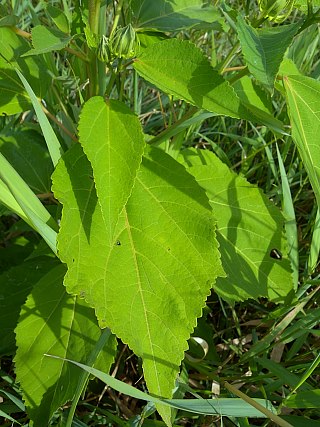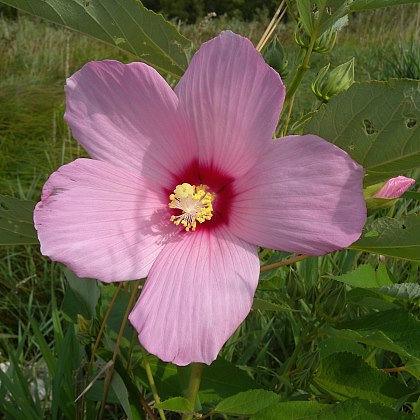Description: This herbaceous perennial wildflower is 3-7' tall and largely unbranched, except for the short flowering stalks along the upper one-fourth of its length. The central stem is terete, light green, and either glabrous or canescent. The alternate leaves are 3-8" long and and 2-4" across; they are ovate to broadly ovate and crenate-dentate along their margins. Some leaves may have a pair of lobes that are shallow and broad. The upper leaf surface is yellowish green to medium green and glabrous (or nearly so), while the lower leaf surface is pale green and canescent. The slender petioles are 2-5" long and either light green or reddish green. At the base of each petiole, there is a pair of small linear stipules. The upper flowering stalks are 1½–3" long and canescent; each stalk has a single leaf and a single flower.

Individual flowers are
4-6" across and a similar length, consisting of 5 white or pink petals,
5 light or yellowish green sepals, a reproductive columnar structure
with numerous stamens along its length and 5 styles with knobby
stigmata at its apex. The persistent sepals are ovate and canescent (or
tomentose); they are united at the base. Each flower usually has a
reddish purple throat at the base of its petals, although sometimes
this is absent. Directly underneath the sepals, there are about 12
linear bracts that curve upward; they are 1" in length. The blooming
period occurs from mid-summer to early fall and lasts about 1 month.
Individual flowers are short-lived; usually only 0-2 flowers are in
bloom at the same time on a single plant. The flowers are replaced by
seed capsules that are about 1–1¼" long and a little less across; they
are globoid-ovoid, short-beaked, and glabrous. Each seed capsule
contains a ring of seeds; individual seeds are reniform, flattened, and
hairless. This wildflower spreads by reseeding itself.
Cultivation:
The preference is full to partial sun, wet to consistently moist
conditions, and soil containing loam, silt, or some sand with organic
material.

Range &
Habitat:
The native Swamp Rose Mallow is found in widely scattered localities
along the
eastern half of Illinois, where it is uncommon. Illinois lies near the
NW range-limit for this species in North America. Swamp Rose Mallow is
also found in east Asia, where some additional color forms exist.
Habitats include marshes, open swamps, and low soggy areas along rivers
and ponds. Along the Atlantic coast of the U.S., this wildflower is
also found in brackish marshes. Because of its attractive flowers,
Swamp Rose Mallow is cultivated occasionally in gardens; some cultivars
display evidence of hybridization with other Hibiscus spp.
(Rose Mallows).
Faunal Associations:
The flowers are cross-pollinated by bumblebees and other long-tongued
bees, including Melitoma taurea and Ptilothrix
bombiformis (Rose Mallow bee). The Rose Mallow bee is a
specialist pollinator (oligolege) of native Hibiscus spp.
(Rose Mallows); it sucks nectar and collects pollen from the flowers,
while other long-tongued bees suck nectar primarily. The Ruby-Throated
Hummingbird is another nectar-seeking visitor of the flowers. Some
insects feed on various parts of Rose Mallows. The introduced pest, Popillia
japonica (Japanese Beetle), gnaws on the flowers and young
leaves, while the aphids Aphis gossypii and Macchiatiella
rhamni suck plant juices. The caterpillars of Pyrgus
communis (Common Checkered Skipper) and the butterfly Vanessa
cardui (Painted Lady) sometimes feed on the leaves, while the
caterpillars of the butterfly Strymon melinus (Gray
Hairstreak) feed on the developing seeds. The caterpillars of several
moths also feed on Rose Mallows, including Acontia delecta
(Delightful Bird-Dropping Moth), Anomis erosa
(Yellow Scallop Moth), Automeris io (Io Moth), and Eudryas
unio (Pearly Wood Nymph).
Photographic Location:
A prairie swale at Meadowbrook Park in Urbana, Illinois.
Comments:
Swamp Rose Mallow has exotic oversized flowers that are very striking,
particularly when they occur in a colony of plants. Other native Hibiscus
spp. (Rose Mallows) in Illinois are similar to Swamp Rose
Mallow in appearance and they are found in similar habitats. These
species include Hibiscus lasiocarpos (Hairy Rose
Mallow) and Hibiscus laevis (Halberd-Leaved Rose
Mallow). Hairy Rose Mallow has felty leaves that are conspicuously
hairy on both their upper and lower surfaces; Swamp Rose Mallow has
leaves that are hairless (or nearly so) on their upper surfaces. Hairy
Rose Mallow also has hairy ovaries/capsules, while the ovaries/capsules
of Swamp Rose Mallow are glabrous. Sometimes Hairy Rose Mallow is
regarded as a subspecies of Swamp Rose Mallow, or Hibiscus
moscheutos lasiocarpos. The remaining similar species,
Halberd-Leaved Rose Mallow, has leaves with divergent basal lobes
(shaped like a halberd) or palmate lobes (maple-leaf shaped), leaf
surfaces that are hairless on both the lower and upper sides, and seeds
that are quite hairy. In contrast, Swamp Rose Mallow lacks such
strongly lobed leaves, the lower surfaces of its leaves are canescent
(or tomentose), and its seeds are hairless. In the past, the
pink-flowered form of Swamp Rose Mallow that lacks a reddish purple
throat was classified as a distinct species, Hibiscus
palustris. However, it is now considered one of several color
forms of Swamp Rose Mallow.